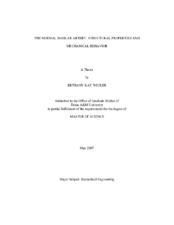| dc.description.abstract | The leading cause of death in patients who survive subarachnoid hemorrhage (SAH) is stroke as a result of cerebral arterial vasospasm1. Such vasospasms involve a vasoactive response, but they remain enigmatic and no clinical treatment has proven effective in prevention or reduction2. Arteries remodel in response to diverse mechanical loads and chemical factors. Following SAH, the surrounding vasculature is exposed to a radically altered chemo-mechanical environment. It is our hypothesis that chemical stimuli associated with the formation of an extravascular blood clot dominates the maladaptive growth and remodeling response early on, thus leading to important structural changes. However, it is not clear which of the many chemical factors are key players in the production of vasospasm. Before an accurate picture of the etiology of vasospasm can be produced, it is imperative to gain a better understanding of the non-pathogenic cerebral vasculature. In particular, the rabbit basilar artery is a well established model for vasospasm. However, surprisingly little is known about the mechanical properties of the rabbit basilar artery. Using an in vitro custom organ culture and mechanical testing device, acute and cultured basilar arteries from male White New Zealand specific pathogen free rabbits underwent cyclic pressurization tests at in vivo conditions and controlled levels of myogenic tone. Sections of basilar arteries were imaged for collagen fiber orientation at 0, 40 and 80 mmHg at in vivo stretch conditions using nonlinear optical microscopy. The nonlinear stress-strain curves provide baseline characteristics for acute and short-term culture basilar arteries. The active and passive testing creates a framework for interpreting the basal tone of arteries in our culture system. Nonlinear optical microscopy second harmonic generation provides unique microstructural information and allows imaging of live, intact arteries while maintaining in vivo geometries and conditions. Collagen fibers were found to be widely distributed about the axial direction in the adventitial layer and narrowly distributed about the circumferential direction in the adventitial layer. The quantified collagen fiber angles within the artery wall further support the development of accurate mathematical models. | en |


